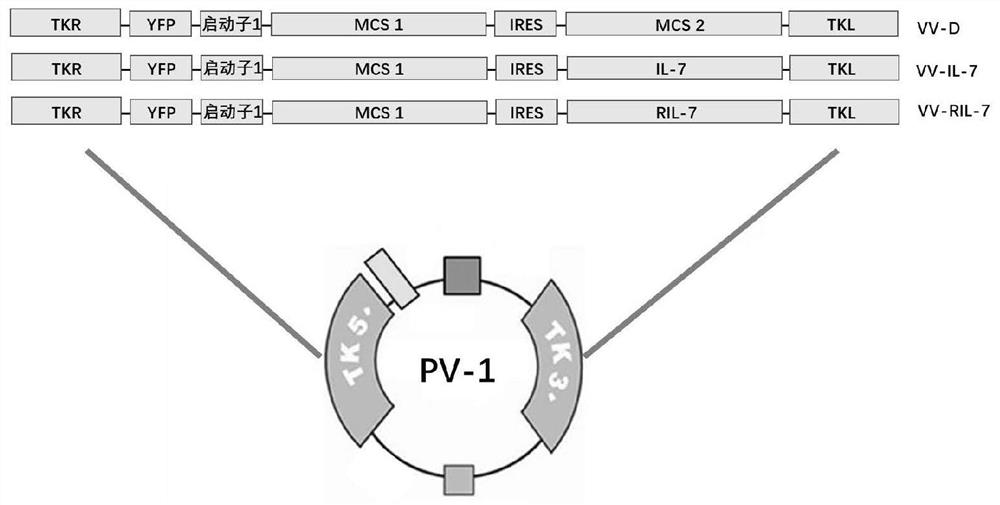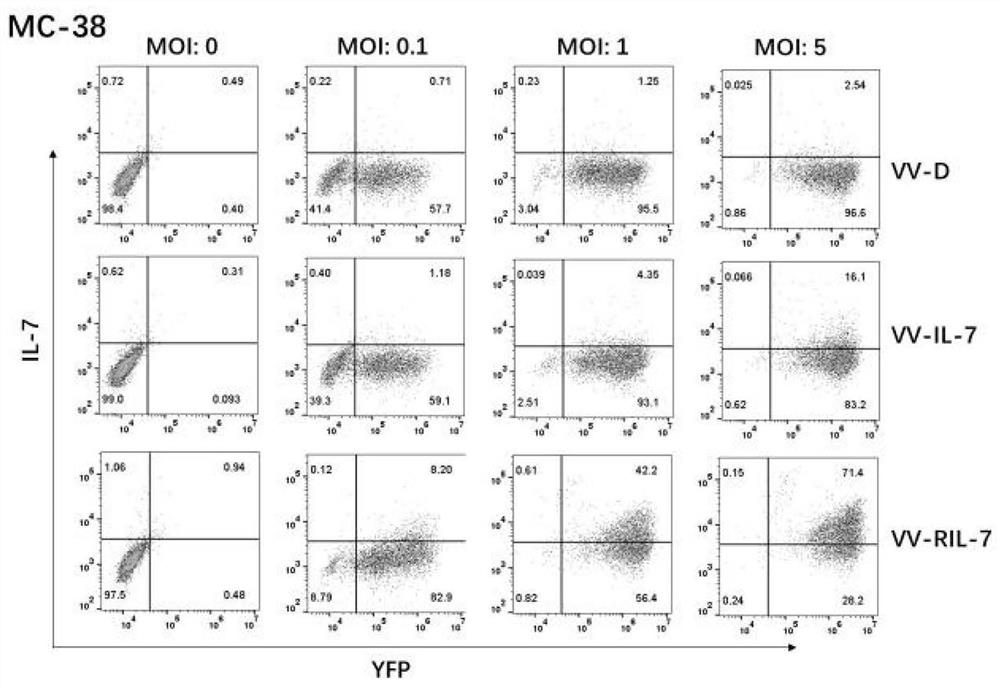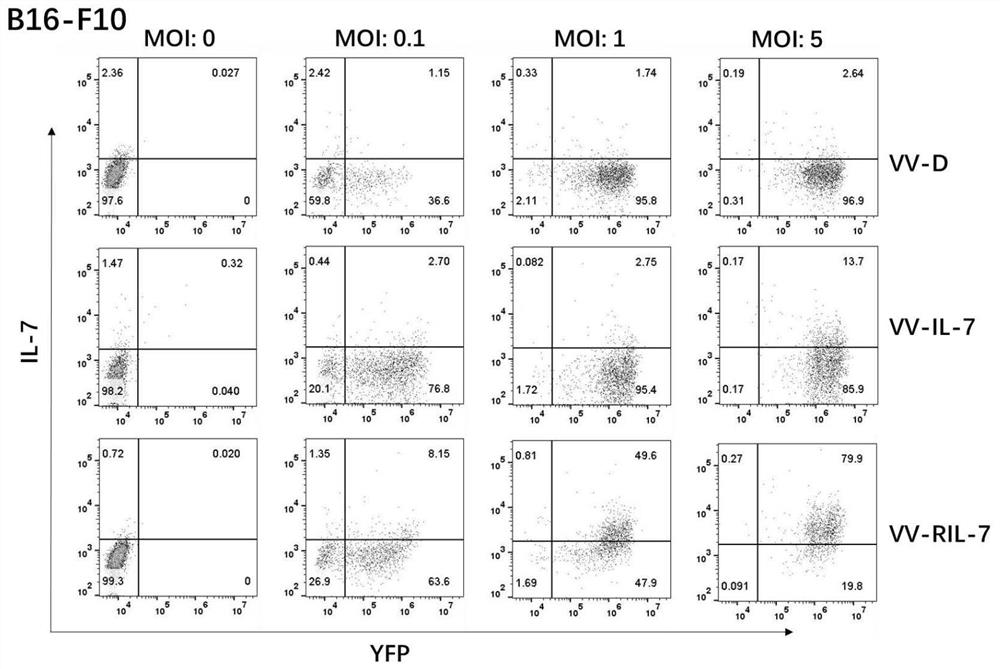Fusion gene RIL-7 recombinant vaccinia virus and application thereof in preparation of antitumor drugs
A RIL-7, anti-tumor drug technology, applied in the field of medicine, can solve the problems of restricting the effect of tumor immunotherapy, blocking the anti-tumor immune circulation, destroying tumor cells, etc. , the effect of avoiding cytokine storm
- Summary
- Abstract
- Description
- Claims
- Application Information
AI Technical Summary
Problems solved by technology
Method used
Image
Examples
Embodiment 1
[0082] 1. Establishment of recombinant oncolytic vaccinia virus VV-RIL-7
[0083] 1) Construction of the fusion gene RIL-7: the gene sequence of the wild-type IL-7 with the termination codon deleted, the EA3K rigid peptide gene sequence [or (G4S)3 flexible linker peptide sequence] and the GPI anchor gene of human CD16b are removed by PCR The sequence was spliced into a new type of fusion gene, named RIL-7 fusion gene, [Note: In the subsequent related expressions, the RIL-7 linked by EA3K is referred to as RIL-7 / EA3K; the RIL-7 linked by (G4S)3 is referred to as RIL-7 / (G4S)3. ].
[0084] 2) Restriction enzyme cutting sites were introduced into the two wings of the fusion gene RIL-7: SdaI and HpaI restriction enzyme cutting sites were introduced into the two wings of the RIL-7 fusion gene by PCR. Enzyme digestion, gel electrophoresis to separate the gene fragments, cut out the fragments of expected size, and use the DNA gel electrophoresis kit to separate the gene fragments ...
Embodiment 2
[0098] Example 2 Test of expression of immune factor RIL-7 in tumor cells infected by recombinant oncolytic virus
[0099] figure 2 MC-38 cells are infected with the RIL-7 fusion gene recombinant oncolytic virus, and the results of detecting the expression of IL-7 in the cell membrane by flow cytometry are shown. figure 2 Shown in is to confirm whether the fusion protein encoded by the RIL-7 gene carried by the recombinant oncolytic virus VV-RIL-7 can be anchored to the cell membrane. After infecting MC-38 cells with VV-RIL-7 recombinant oncolytic virus, the expression of IL-7 in the cell membrane was detected by staining with anti-IL-7 monoclonal antibody and flow cytometry. The results showed that the presence of membrane-anchored IL-7 was detected on the surface of the intestinal cancer cell MC38 cell membrane of the VV-RIL-7 infection group after recombination into the RIL-7 gene, while VV-D (only the VV with the TK gene knocked out), There was no presence of membrane-...
Embodiment 3
[0106] Embodiment 3 biological activity test
[0107] In order to identify whether the expression product of the fusion gene RIL-7 carried by the recombinant vaccinia virus has biological activity, T cells were obtained from spleen cells in this experiment, and divided into a resting T cell group and a PHA-activated T cell group and seeded in 96-well plates respectively. After infecting MC-38 cells with different recombinant vaccinia viruses at MOI=1 for 24 hours, digest and prepare single cell suspension, after washing with PBS, add the resting T cell group and PHA activated T cell group in proportion, and after co-incubating for 48 hours, use the MTT method The OD (optical density) value of each group was detected. The results showed that tumor cells infected with recombinant vaccinia virus carrying the RIL-7 gene could effectively stimulate the proliferation of resting and activated T cells, and this effect could be blocked by an anti-IL-7 neutralizing antibody, further dem...
PUM
| Property | Measurement | Unit |
|---|---|---|
| molecular weight | aaaaa | aaaaa |
| molecular weight | aaaaa | aaaaa |
Abstract
Description
Claims
Application Information
 Login to View More
Login to View More - R&D
- Intellectual Property
- Life Sciences
- Materials
- Tech Scout
- Unparalleled Data Quality
- Higher Quality Content
- 60% Fewer Hallucinations
Browse by: Latest US Patents, China's latest patents, Technical Efficacy Thesaurus, Application Domain, Technology Topic, Popular Technical Reports.
© 2025 PatSnap. All rights reserved.Legal|Privacy policy|Modern Slavery Act Transparency Statement|Sitemap|About US| Contact US: help@patsnap.com



